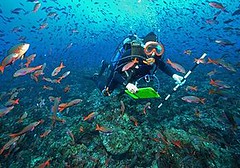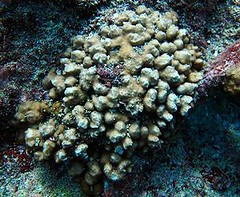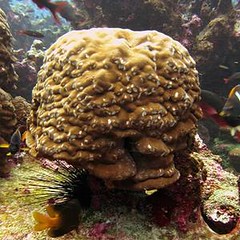 加拉巴哥群島過去一個半世紀大大出名,但達爾文應該不會預料到,群島的繽紛生態也包含了珊瑚礁──科學家一直到1970年代,才發現到加拉巴哥群島的確有珊瑚存在;但是,到了1983年,第一份研究加拉巴哥珊瑚礁形成的報告才剛出版,它們幾乎就被聖嬰現象摧毀了。
加拉巴哥群島過去一個半世紀大大出名,但達爾文應該不會預料到,群島的繽紛生態也包含了珊瑚礁──科學家一直到1970年代,才發現到加拉巴哥群島的確有珊瑚存在;但是,到了1983年,第一份研究加拉巴哥珊瑚礁形成的報告才剛出版,它們幾乎就被聖嬰現象摧毀了。
今年夏天進行的珊瑚礁調查發現,部分島嶼的珊瑚群落有復甦的跡象。牠們奮力求生可作為全球珊瑚的借鏡,目前預測,全球珊瑚礁的3/4,在2030年都將遭受長期的損害。
對珊瑚成長而言,加拉巴哥群島是個艱苦的環境。群島位處東太平洋的赤道區,為五道主要大洋流(包含表層暖洋流及深層冷洋流)的交匯處。而洋流交匯的結果,造成島嶼間與季節性的海洋氣候劇烈變化,這對水溫敏感的珊瑚來說並非理想的成長環境。
1970年代研究者發現,群島的確擁有珊瑚,尤其在北邊溫水環繞的島嶼,有些甚至已聚集成礁。
而在1982年到1983年,反常的聖嬰氣候帶入更高溫的海水,導致加拉巴哥群島超過90%的珊瑚死亡。溫暖的海水會使珊瑚喪失共生藻,除了會導致珊瑚白化外,也會使得珊瑚容易罹患疾病。
1997-1998年的強烈聖嬰現象再一次影響珊瑚的命運,但這一次部分珊瑚存活下來。
蘇爾坦海洋生物基金會(Khaled bin Sultan Living Oceans Foundation)的「全球珊瑚礁探險」(Global Reef Expedition)計畫研究團隊預定以6年對全球珊瑚礁進行調查,今年6月費時18日,以金色魅影號研究船在拉巴哥群島的其中八個島嶼外進行調查。期待瞭解過去數十年間聖嬰現象蹂躪過後珊瑚的恢復狀況,及瞭解珊瑚適應環境干擾的重要因子。
研究團隊的首席科學家Andrew Bruckner表示,「加拉巴哥群島提供了獨一無二的野外研究室,讓我們得以瞭解極端氣溫及酸性的增加如何影響造礁珊瑚未來的存活及生長。」
整體而言,研究團隊發現在北邊的三個島嶼:馬切納島、狼島及達爾文島,珊瑚有恢復的跡象。
 1983年進行研究的共同作者,也是本次研究團隊成員Peter Glynn說明,「這個結果令人振奮:雖然南部的島嶼看起來很難恢復到1983年以前的水平,另一方面,即便牠們不能造礁,常見的大珊瑚卻出乎意料的在中部及南部的島嶼茂盛生長著。」
1983年進行研究的共同作者,也是本次研究團隊成員Peter Glynn說明,「這個結果令人振奮:雖然南部的島嶼看起來很難恢復到1983年以前的水平,另一方面,即便牠們不能造礁,常見的大珊瑚卻出乎意料的在中部及南部的島嶼茂盛生長著。」
小組的成員、美國海洋暨大氣總署的Derek Manzello檢視環繞加拉巴哥群島海水中二氧化碳的高含量對珊瑚生長率的影響。
這些島嶼擁有豐富的海洋生物是因為冷洋流自深海將營養物質往上帶,而相同的冷洋流也帶入分解作用的副產品–大量的二氧化碳。過去一世紀全球二氧化碳上升了1/4,而多餘的二氧化碳進入海水導致海水酸化,加拉巴哥群島珊瑚的情況或許可提供未來全球珊瑚礁的借鏡。
酸化的海水會中止碳酸鈣的形成,由於碳酸鈣為礁岩的主要硬體結構物質,因而酸化的海水會使礁岩脆化。
根據取自冰蕊的樣本,Manzello發現北部島嶼的二氧化碳濃度比工業化前高了40%,跟研究者在整個熱帶地區發現的濃度相近。
對照來看,南部島嶼的二氧化碳相較於前工業時代約增加了1倍,這或許可以解釋南部島嶼的珊瑚為什麼沒有北部島嶼一樣的恢復。

團隊另一位成員,賓州大學的Iliana Baums解釋兩種類似的造礁珊瑚的繁殖策略,及珊瑚的繁殖行為如何依賴牠們周遭的礁岩生物群落。
團塊微孔珊瑚(Porites lobata)行有性生殖,藉由排放精子及卵子進入海水,受精卵藉由海水帶到的地方長出新的珊瑚。
團柱微孔珊瑚(Porites evermanni)通常進行無性生殖,通常是鱗魨科魚類搜尋生長在珊瑚內的貽貝時咬下一塊珊瑚,從這塊破片可以再長出新的個體。
無性生殖的限制是珊瑚會在原個體附近生長,而有性生殖可以在較遠的地方建立新的群落。在加拉巴哥群島,雖然珊瑚體內的貽貝很常見,可以咬開珊瑚的鱗魨科魚類卻不多見。
Baums發現,團柱微孔珊瑚不像以往那麼多可能跟牠們繁殖策略需要魚的協助有關。氣候變遷不但藉由海水溫度上升影響珊瑚,藉由影響貽貝及魚類的數量也間接影響珊瑚。
「全球珊瑚礁探險」是由馬里蘭州的蘇爾坦海洋生物基金會進行的計畫。目的是調查及繪製地處偏遠的珊瑚礁群──通常是在那些無力自行進行相關研究的國家,來協助確認需要高度優先保護的地區。基金會也全額贊助當地的科學家組成研究團加入他們的團隊,在每個任務結束後所有的資料和繪製圖將移交給珊瑚所屬國。
「全球珊瑚礁探險」2011年從加勒比海開始他們的6年計畫,調查巴哈馬群島、聖克里斯多福及尼維斯、牙買加、納弗沙島、哥倫比亞及加拉巴哥群島的珊瑚礁。金色魅影號目前在南太平洋,將一路向西航行全球至2017年。
The Galapagos Islands have been famous for a century and a half, but even Charles Darwin did not suspect that the archipelago’s list of living wonders included coral reefs. It took until the 1970s before scientists realized that the islands do, in fact, have coral. But in 1983, the year the first major report on Galapagos reef formation was published, they were almost obliterated by El Niño.
This summer, a major coral survey found that some of the islands’ coral communities are showing promising signs of recovery. Their struggle to survive may tell us what is in store for the rest of the world, where almost three-quarters of corals are predicted to suffer long-term damage by 2030.
The Galapagos are a tough place for coral to grow. Directly on the equator in the eastern Pacific, the islands sit at the intersection of five major ocean currents, both warm surface currents and cool, deep currents.
The result is a marine climate that changes rapidly from island to island and season to season – not an ideal situation for organisms that are especially sensitive to changes in water temperature.
Yet, in the 1970s researchers discovered that numerous places in the 16-island archipelago did have coral, some of which had accumulated into reefs, especially in the warmer waters around the northernmost islands.
Then, the unusually strong 1982-1983 El Niño climate event brought warmer waters that killed over 90 percent of corals in parts of the Galapagos. Warm waters cause corals to lose their crucial symbiotic algae, which causes bleaching and leaves them more prone to disease.
Another strong El Niño in 1997-1998 threatened to seal their fate, but some corals managed to survive.
In June, a team of researchers with the Khaled bin Sultan Living Oceans Foundation’s Global Reef Expedition, a six-year survey of coral reefs worldwide, spent 18 days aboard the Golden Shadow research vessel in the Galapagos, surveying the corals of eight islands. They wanted to see how the corals had recovered from the ravages of recent decades, and what were the most important factors that made them resilient to environmental disturbances.
“The Galapagos offered a unique field laboratory to help us better understand how temperature extremes and increasing acidity will affect the survival and growth of reef building corals in the future,” says Andrew Bruckner, chief scientist for the expedition.
Overall, the team found signs of coral recuperation at three northern islands: Marchena, Wolf and Darwin.
“That’s encouraging,” says team member Peter Glynn, co-author of the 1983 study. “The southern islands, though, are showing very little in the way of recovery to pre-1983 levels. On the other hand, the most common large corals were surprisingly abundant in the central and southern islands, even though they weren’t aggregated into reefs.”
Team member Derek Manzello of NOAA looked at how the relatively higher levels of carbon dioxide, CO2, in the waters around the Galapagos affected coral growth rates.
The islands owe their wealth of marine life to the deep, cold currents that bathe them in nutrients brought up from the ocean depths. These same currents also bring high amounts of CO2, a byproduct of decomposition. This situation could make the islands a window into the future of reefs around the world, since about a quarter of the CO2 produced in the past century has ended up in the ocean, where it makes the waters more acidic.
Acidic waters weaken reefs by interrupting the creation of calcium carbonate, the substance that provides their hard structure.
Manzello found CO2 levels in the northern islands were about 40 percent higher than they were in preindustrial times, based on samples taken from ice cores, which is similar to levels researchers are finding throughout the tropics.
In comparison, CO2 levels around the southern islands have roughly doubled since pre-industrial times, which could explain why corals there are not recovering as well as they are farther north.
Another member of the expedition, Iliana Baums of Penn State University, examined how two similar species of reef-building coral reproduce, and how this depends on the reef community surrounding them.
Porites lobata reproduces sexually, by releasing sperm and/or eggs into the water, which are carried off to found new coral.
Its identical-looking relative Porites evermanni often reproduces asexually, which can happen when pieces break off – in its case, from certain species of triggerfish biting off pieces of coral in search of mussels that live inside – and form new corals nearby.
Asexual fragmentation is limited to the immediate vicinity, while sexual reproduction can “reseed” new coral communities over much longer distances. In the Galapagos, the mussels are common but triggerfish of the right species are not.
Baums found that fragmenting Porites evermanni does not grow there as often, possibly because they need the fish to reproduce. So climate change could affect the coral not only by raising the water temperature, but also by how it affects the mussels and fish.
The Global Reef Expedition is a project of the Khaled bin Sultan Living Oceans Foundation in Landover, Maryland. The goal is to survey and map remote coral reefs, often in countries who are not able to do it themselves, to help identify high-priority sites for protection.
Local scientists team up with researchers brought in by the foundation, which assumes all the costs. All data and maps are turned over to the host countries at the end of each mission.
The Global Reef Expedition started its six-year mission last year in the Caribbean, surveying reefs in the Bahamas, St. Kitts & Nevis, Jamaica, Navassa, Colombia and the Galapagos. The Golden Shadow is currently in the South Pacific, and will work its way west around the globe until 2017.
※ 全文及圖片詳見:ENS





